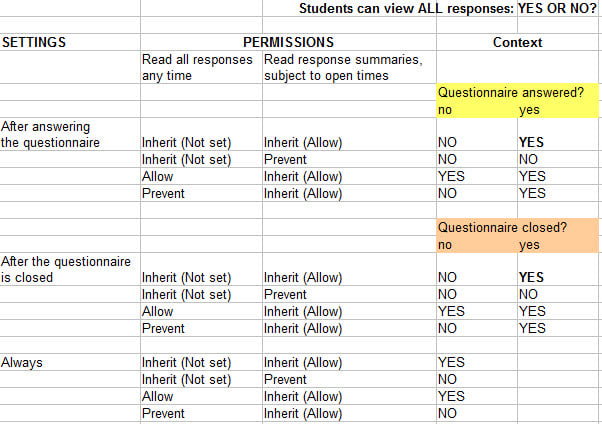Adding/editing a questionnaire
Moodle questionnaires enable staff to obtain feedback from students, with an option for the results to be anonymous. To help with consistency and reduce repetitive tasks template questionnaires can be constructed and deployed across any number of modules.
To add a questionnaire you should turn on the editing and select it from the Activity chooser. If you cannot find it in here, it may be that it has not been installed.
Settings
The following sections describe the settings possible for questionnaires.
Name
Enter a name that describes the purpose of the questionnaire. This is what students will click on to access it on the Moodle course homepage.
Description
Add an optional description explaining how and why students should complete the questionnaire. Note: If you are allowing students to Save/Resume answers you might like to explain this here.
Timing
Set the date window for when users can complete the questionnaire. You can leave the boxes unchecked if you want the questionnaire to be continually available.
Response options
Type
Select whether users will be allowed to respond once, daily, weekly, monthly or an unlimited number of times (many).
Respondent Type
You can display your users' full names with each response by setting this to "fullname".
You can hide your users' identities from the responses by setting this to "anonymous".
Once the "anonymous" option has been set in a questionnaire, it's impossible to revert to the "fullname" option, for obvious privacy reasons. So be careful when you set your questionnaire to "anonymous".
Note: If your Moodle course allows guests, they will only be allowed to respond to a questionnaire whose responses have been set to anonymous.
Respondent Eligibility
Decide whether everyone can answer or whether you want to restrict it to tutor only or student only responses. For restricted access options remember to assign the correct roles either at the course or activity level. For example, if you put a questionnaire on the front page, intended for teachers only, then you will have to let Moodle know which users are teachers.
ALL Responses viewing
WHEN
You can specify when Roles with the "Read response summaries subject to open times" capability can see the responses of ALL respondents to submitted questionnaires (i.e. the general statistics tables).
Students can view ALL responses ->
- After answering the questionnaire.
- After the questionnaire is closed.
- Always.
- Never.
WHO (Which role can see what)
Starting with Questionnaire version 2.5, the "WHO" can view the ALL Responses report page settings have been moved to the Roles and Permissions settings.
As with all other Roles and capabilities settings in Moodle, you can set those permissions at site level, course level or activity level.
The following table sums up the correlation between the Questionnaire Response Options Settings and the Permissions settings. As you can see, the Roles and Permissions settings can OVERRIDE the Response options settings.
Note: 3.3 added the 'Never" option. If this is selected, and the user does not have the "Read all responses any time" capability, then they will not be able to see all the responses at any time.
Send submission notifications
3.2.4 added this setting. Setting this to "Yes" will use the Moodle notification system to notify roles with the "mod/questionnaire:submissionnotification" capability when a submission is made.
Save/Resume answers
Setting this option allows users to save their answers to a questionnaire before submitting them. Users can leave the questionnaire unfinished and resume from the save point at a later date.
Allow branching questions
The Conditional Branching feature enables the Questionnaire creator to "branch" the respondent to different pages according to their choice of response to Yes/No, Dropdown boxes or Radio button questions. This option is enabled by default when you create a new questionnaire. If you do not plan to use this feature in the questionnaire, you should set it to No.
Auto numbering
If you have multiple questions or pages, you can choose to split them up and number them. You might want to disable automatic numbering for questionnaires with conditional branching.
- Do not number questions or pages.
- Auto number questions.
- Auto number pages.
- Auto number pages and questions.
Submission grade
Unlike the Quiz or Lesson Moodle activities the questionnaire activity is not meant to test the student's knowledge and therefore the responses cannot/should not be graded as correct or incorrect. However, in order to encourage the students to complete a questionnaire, you may choose to award the student a grade (on a 1-100 scale) upon completion.
Content Options
Select one of the radio button options. 'Create new' is the default.
You can create questionnaires using three different methods:
- Create New:
- This option allows you to create a completely new questionnaire from scratch.
- Copy Existing:
- This option copies a pre-existing questionnaire's content to a new questionnaire, pre-seeding the content. You can copy questionnaires belonging to the course, or ones specifically marked as 'template'.
- Use Public:
- If a questionnaire has already been created (in another course on the same Moodle site) with the "public" setting, then you may use that "public" questionnaire in your own course(s). The number of settings available to such questionnaires is limited and you cannot edit its questions nor view the responses.
Example .- If a public questionnaire has been created in course A, it can be "used" in courses B, C, ... All the responses from courses A, B, C, ... are collected in the public questionnaire created in course A (the original course where it was created) and are viewable there by the person (admin or teacher) who originally created it.
- If a questionnaire has already been created (in another course on the same Moodle site) with the "public" setting, then you may use that "public" questionnaire in your own course(s). The number of settings available to such questionnaires is limited and you cannot edit its questions nor view the responses.
What next?
Once you have clicked Save:

